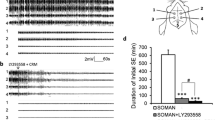Abstract
The potential of a single dose of malaoxon (26.2 or 39.2 mg/kg i.p.) to produce convulsions and to increase cerebral levels of inositol-1-phosphate (Ins1P), an intermediate in phosphoinositide (PI) cycle, was followed for 1, 4, or 72 hr. The lower dose of malaoxon did not produce convulsions whereas the higher dose induced convulsions in 60% of the exposed rats. Malaoxon caused a dosedependent, at most 2-fold, increase in brain regional Ins1P levels in nonconvulsing rats as compared to controls. At the higher dose of malaoxon, in convulsing rats, the Ins1P-levels increased 4-fold above the control Ins1P-levels. In nonconvulsing rats, the Ins1P-levels reached their maximum 1–4 hr after the administration of malaoxon, whereas in convulsing rats the levels increased for 72 hr. The results suggest that PI-signalling is associated with convulsions produced by malaoxon.
Similar content being viewed by others
References
Meldrum, B. S. 1986. Cell damage in epilepsy and the role of calcium in cytotoxicity. Adv. Neurol. 44:849–855.
Olney, J. W., Collins R. C., and Sloviter R. S. 1986. Excitotoxic mechanism of epileptic brain damage. Adv. Neurol. 44:857–878.
Collins, R. C., Lothman E. W., and Olney J. W. 1983. Status epilepticus in the limbic system: Biochemical and pathological changes. Adv. Neurol 34:277–288.
Pazdernik, T. L., Cross, R. S., Giesler, M., Samson F. E., and Nelson, R. S. 1985. Changes in local cerebral glucose utilization induced by convulsants. Neuroscience 14:823–835.
Flynn, C. J., and Wecker, L. 1986. Elevated choline levels in brain: A noncholinergic component of organophosphate toxicity. Biochem. Pharmacol. 35:3115–3121.
Gonchar, M. P., Olney, J. W., and Sherman, W. R. 1983. Systemic cholinergic agents induced seizures and brain damage in lithium-treated rats. Science 220:323–325.
Gonzales, R. A., and Crews, F. T. 1985. Cholinergic- and adrenergic-stimulated inositide hydrolysis in brain: Interaction, regional distribution, and coupling mechanisms. J. Neurochem. 45:1076–1084.
Savolainen, K. M., Terry, J. B., Nelson, S. R., Samson F. E., and Pazdernik, T. L. 1988. Convulsions and cerebral inositol-1-phosphate levels in rats treated with diisopropyl fluorophosphate. Pharmacol & Toxicol 63:137–138.
Rooney, T. A., Nahorski, S. R. 1986. Regional characterization of agonist and depolarization-induced phosphoinositide hydrolysis in rat brain. J. Pharmacol. Exp. Ther. 239:873–880.
Fisher, S. K., and Agranoff, B. W. 1986. Receptor activation and inositol lipid hydrolysis in neural tissues. J. Neurochem. 48:999–1017.
Berridge, M. J., and Irvine, R. F. 1984. Inositol trisphosphate, a novel second messenger in cellular signal transduction. Nature (London) 312:315–321.
Berridge, M.J. 1986. Inositol phosphates as second messengers. Pages 25–45in Putney, J. W. (ed.), Phosphoinositides and receptor mechanisms, Alan R. Liss, Inc., New York.
Irvine, R. F. 1986. The structure, metabolism, and analysis of inositol phosphates. Pages 89–107,in Putney, J. W. (ed.), Phosphoinositides and receptor mechanisms, Alan R. Liss., Inc., New York.
Berridge, M. J., Downes, C. P., and Hanley, M. R. 1982. Lithium amplifies agonist-dependent phosphatidyl-inositol responses in brain and salivary glands. Biochem. J. 206:587–598.
Sherman, W. R., Gish, B. G., Honchar, M. P., and Munsell, L. Y. 1986. Effects of lithium on phosphoinositide metabolism in vivo. Fed. Proc. 45:2639–2646.
Pellegrino, L. J., Pellegrino, A. S., and Gushman, A. J. 1979. A Stereotaxic atlas of the rat brain, 2nd ed., Plenum Press, New York.
Hirvonen, M.-R., Lihtamo, H., Savolainen, K. 1988. A gas chromatographic method for the determination of inositol monophosphates in rat brain. Neurochemical Research (in press).
Hirasawa, K., and Nishizuka, Y. 1985. Phosphatidylinositol turnover in receptor mechanism and signal transduction. Ann. Rev. Pharmacol. Toxicol. 25:147–170.
Kikkawa, U., and Nishizuka, Y. 1987. Inositol phospholipid turnover and protein kinase C in stimulus-response coupling. Biochem. Soc. Transact. 15:124–125.
Hallcher, L. M., and Sherman, W. R. 1980. The effects of lithium ion and other agents on the activity of myo-inositol-1-phosphatase from bovine brain. J. Biol. Chem. 225:10896–10901.
Olney, J. W., deGubareff, T., and Labruyere, J. 1983. Seizurerelated brain damage induced by cholinergic agents. Nature (London) 301:520–522.
Piredda, S., Lim C. R., and Gale, K. 1985. Intracerebral site of convulsant action of biculline. Life Sci. 36, 1295–1298.
Piredda, S., and Gale, K. 1986. Role of excitatory amino acid transmission in the genesis of seizures elicited from the deep prepiriform cortex. Brain Res. 377:205–210.
Browning, R. A. 1986. Neuroanatomical localization of structures responsible for seizures in the GEPR: Lesion studies. Life Sci. 39:857–867.
Kuhar, M. I., and Yamamura, I.H. 1975. Light autoradiographic localization of cholinergic muscarinic receptors in rat brain by specific binding of a potent antagonist. Nature (London) 253:560–561.
Churchill, L., Pazdernik, T. L., Samson, F., and Nelson, S. R. 1984. Topographical distribution of down-regulated muscarinic receptors in rat brains after repeated exposure to diisopropyl phosphofluoridate. Neuroscience 11:463–472.
Jope, R. S., Simonato, M., and Lally, K. 1987. Acetylcholine content in rat brain is elevated by status epilepticus induced by lithium and pilocarpine. J. Neurochem. 49:944–951.
Shih, T.-M., 1982. Time course effects of soman on acetylcholine levels in six discrete areas of the rat brain. Psychopharmacology 78:170–175.
Fonnum, F., and Guttormsen, D. M. 1969. Changes in acetylcholine content of rat brain after toxic doses of di-isopropyl phosphorofluoridate, Experientia 25:505–506.
Author information
Authors and Affiliations
Rights and permissions
About this article
Cite this article
Hirvonen, MR., Komulainen, H., Paljärvi, L. et al. Time-course of malaoxon-induced alterations in brain regional inositol-1-phosphate levels in convulsing and nonconvulsing rats. Neurochem Res 14, 143–147 (1989). https://doi.org/10.1007/BF00969629
Accepted:
Issue Date:
DOI: https://doi.org/10.1007/BF00969629




